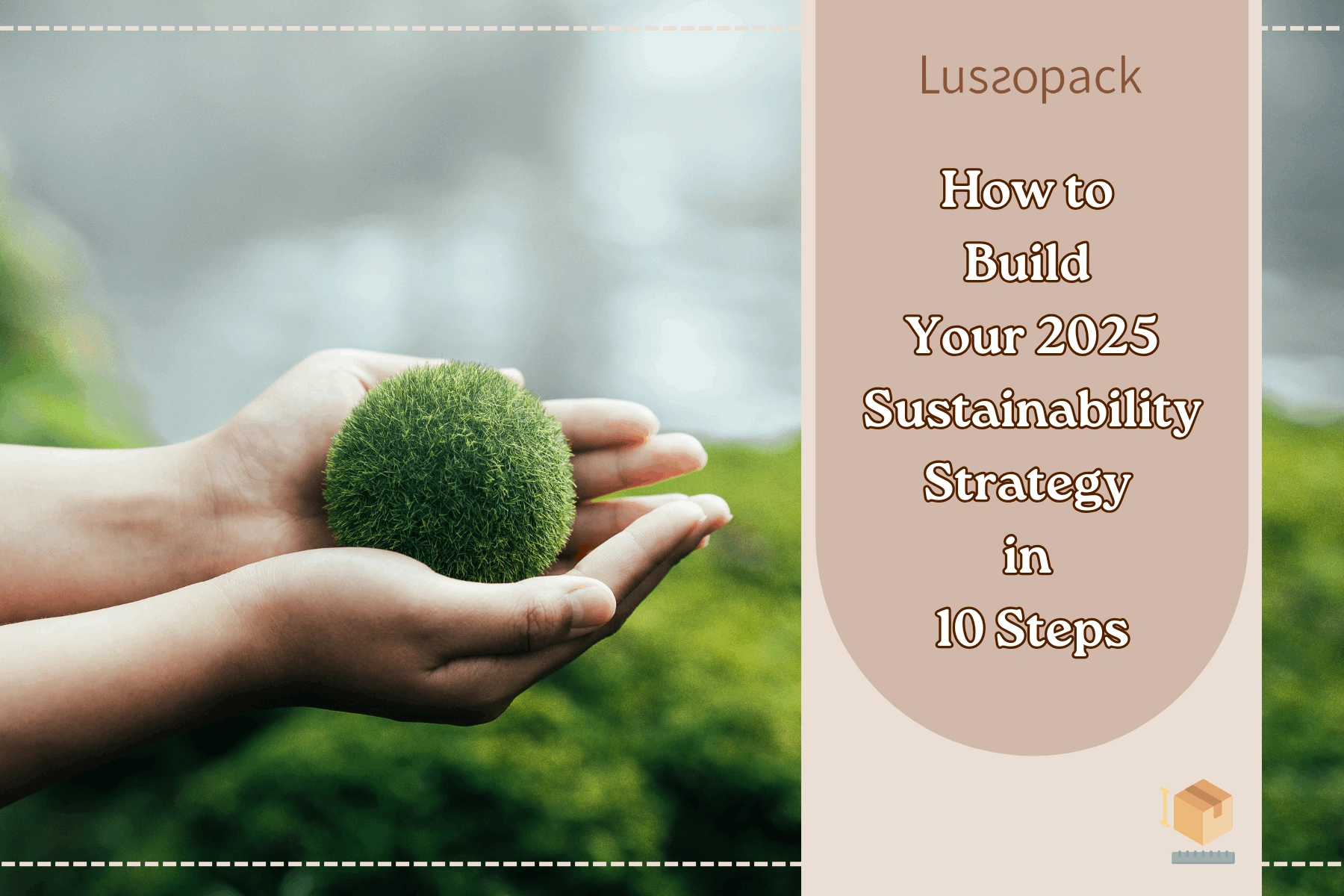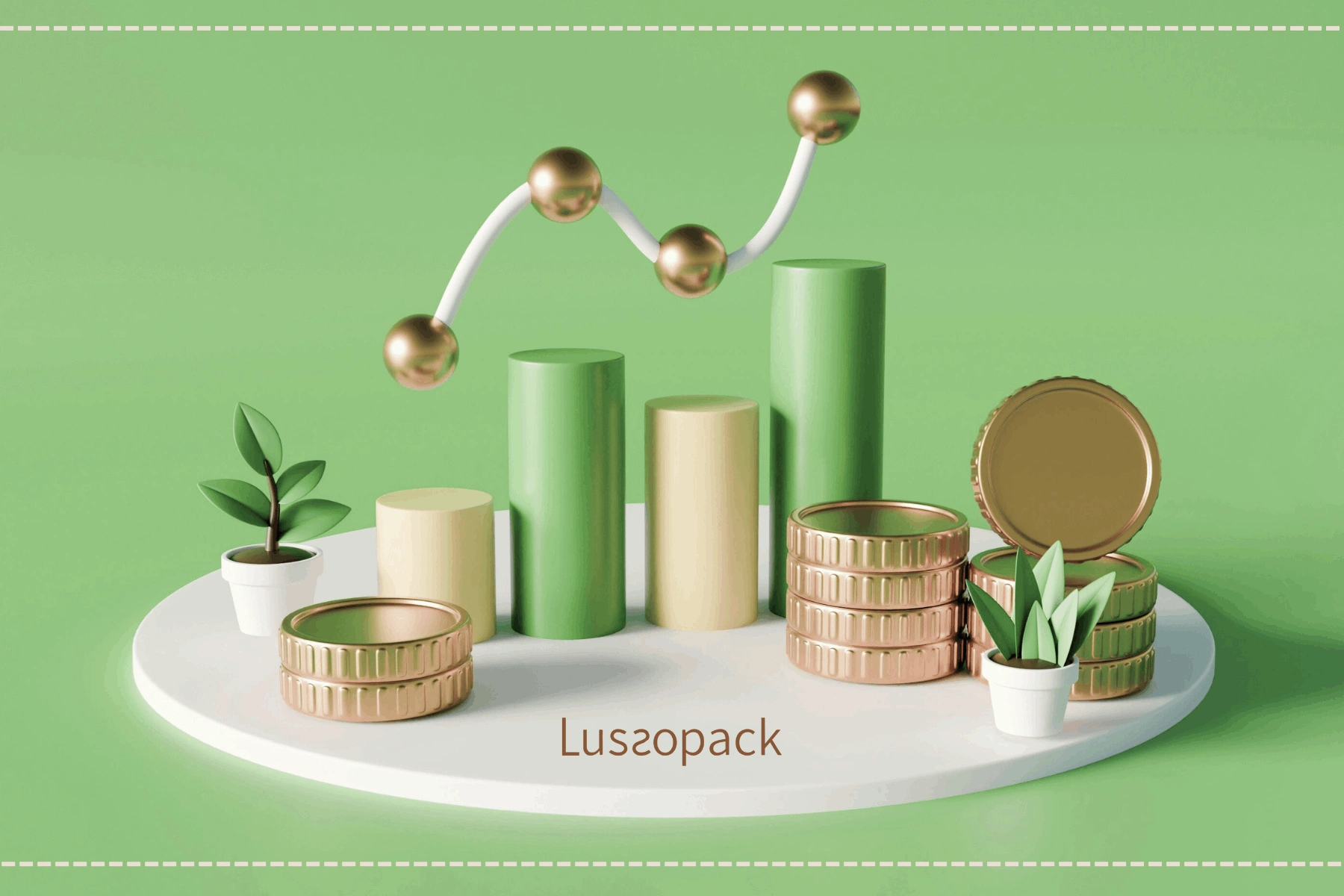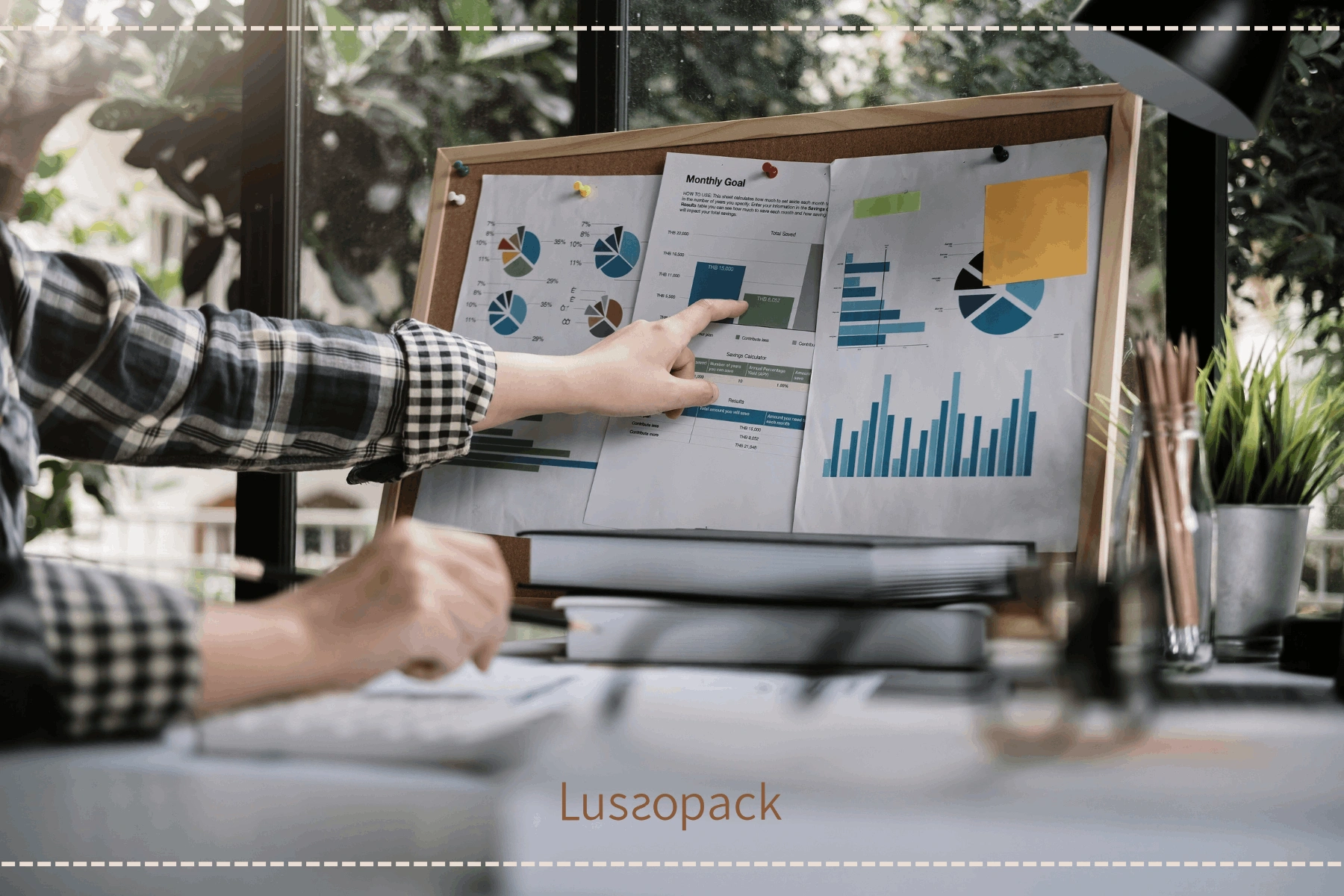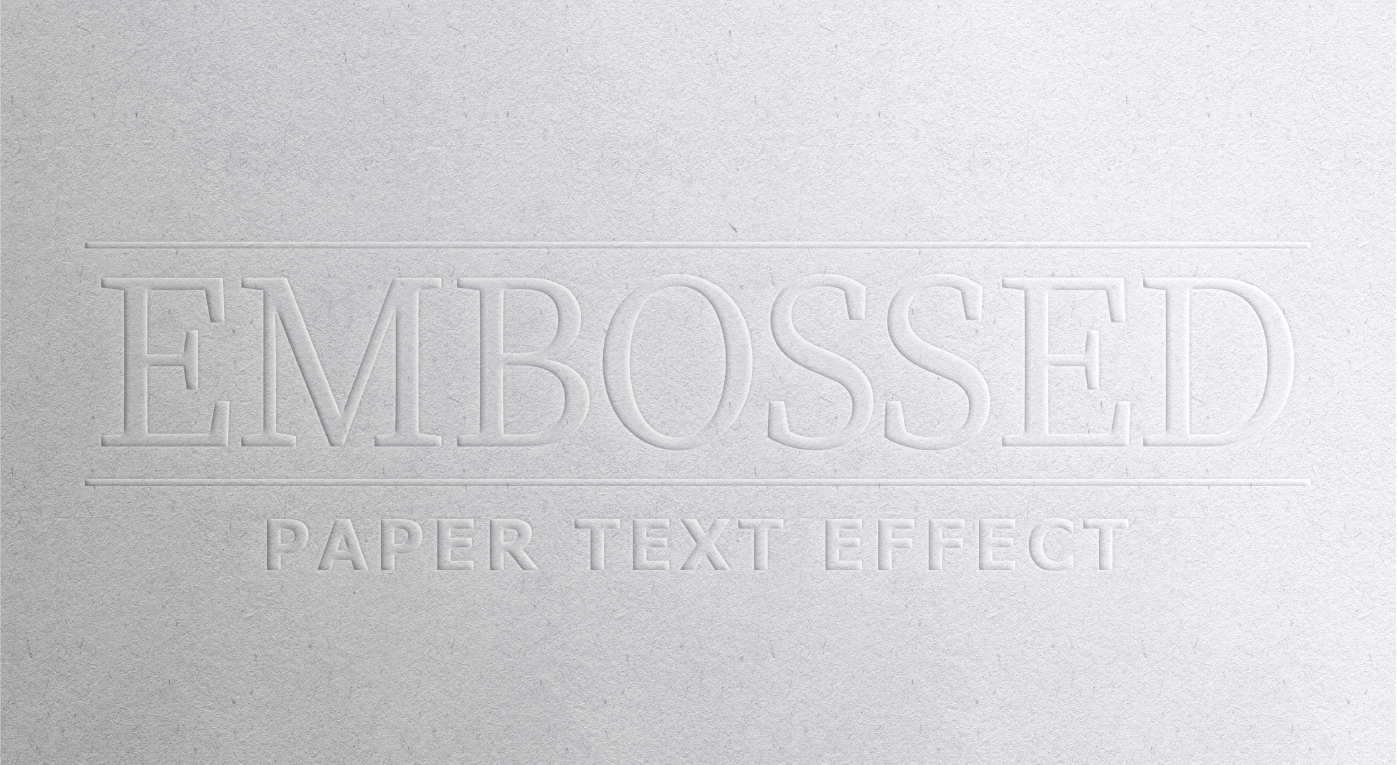How to Build Your 2025 Sustainability Strategy in 10 Steps
Article by : Lussopack

Sustainability is no longer optional; it’s something every business needs to prioritize. With climate concerns growing, customer expectations changing, and new rules coming into play, companies are under more pressure than ever to act responsibly.
Looking ahead to 2025, it’s the perfect time to set a clear plan in motion. So, where should you begin? And how do you make sure your strategy actually works? Even if you already have a plan in place, or you're just beginning to think about sustainability, these 10 steps can help you create a strategy that drives real progress.
1. Understand What a Sustainability Strategy Really Means

Before setting any goals, it helps to get clear on what sustainability really involves. What is a sustainability strategy? It’s a plan that helps your business reduce harm to the environment, support people and communities, and stay financially healthy. In short, it’s about doing business in a way that’s better for everyone now and in the future.
A strong corporate sustainability strategy is built around the three pillars of sustainability: environmental, social, and economic.
- Environmental pillar: This is about how your business affects the planet. It includes things like cutting energy use, lowering emissions, managing waste, and using resources more responsibly. Even small steps like choosing better materials or switching to sustainable packaging can make a big difference.
- Social pillar: This focuses on people. That means treating workers fairly, supporting local communities, protecting human rights, and creating a safe, inclusive workplace. Businesses that care about people tend to earn more trust and loyalty in return.
- Economic pillar: This is about running your business in a smart, sustainable way. Profit still matters, but it shouldn’t come at the expense of ethics or the environment. A good sustainable growth strategy finds the balance between doing well and doing good.
When these three areas work together, they create a strong foundation for long-term success with a positive impact that goes far beyond your bottom line.
2. Assess Your Current Footprint
Start by evaluating where you stand. Take a fresh look at how your business runs: energy use, waste, water, materials, and especially your packaging's environmental impact. Don’t forget your supply chain; that’s often where unseen issues begin.
Focus on quick, meaningful changes like reducing waste or switching to sustainable packaging. Even small changes can add up fast. This step helps you spot what’s working, what’s not, and where there’s room to do better, all while saving money and running more efficiently.
3. Set Clear, Ambitious but Achievable Goals

Now that you know your impact, it’s time to make a plan. Set both short-term and long-term objectives. If your long-term ambition is to reach net zero targets by 2040, define what needs to happen by 2025, 2030, and so on
Break it down into actionable goals:
- Reduce energy use by 15% in two years
- Eliminate all single-use plastic in packaging
- Ensure 100% of suppliers meet ethical sourcing standards
These clear targets will shape the backbone of your sustainable growth strategy and make progress measurable.
4. Define Your Sustainability Priorities
Don’t try to fix everything at once. Every business has different areas that matter most, so your strategy should reflect that. Focus on what has the biggest impact in your industry and what your customers and stakeholders care about.
For example:
- A luxury fashion brand might focus on ethical sourcing, biodegradable textiles, and eliminating plastic garment bags.
- A technology brand might focus on energy-efficient data centers, device recycling, or cutting down on e-waste.
- A cosmetics brand could invest in refillable packaging, cruelty-free testing, and cleaner formulations.
- A food and beverage company might tackle food waste, water usage, and renewable energy in production.
- A jewelry brand could focus on responsibly mined materials, carbon-neutral shipping, premium sustainable packaging, and creative jewelry display ideas that align with its eco-conscious image.
Knowing your most relevant impact areas helps you set clear, focused goals and makes your efforts feel more authentic. Identify the types of sustainability most relevant to your model and start there.
5. Engage Stakeholders Early

Your sustainability plan won’t succeed in isolation. Bring your internal and external stakeholders into the conversation early. Employees, investors, suppliers, and even customers can offer valuable insights, and their support is essential for real change.
Involve teams from different departments, from operations to marketing, so that sustainability becomes part of daily decision-making. Tools like customer feedback, supplier sessions, or in-house sustainability leads can help keep the momentum going. When people feel heard and involved, they’re more likely to support and drive your goals forward.
6. Integrate ESG into the Core of Your Business
Sustainability shouldn’t be an afterthought; it needs to be part of how your business works every day. Why is ESG (Environmental, Social and Governance) important? In simple terms, ESG reflects how your company manages its impact on the environment, people, and ethical standards. It’s something customers, investors, and even employees care about, and it plays a growing role in how companies are judged.
ESG only drives real results when it’s built into the foundation of your business. Which means:
- Making ESG goals part of your business strategy.
- Backing up your goals with real numbers and measurable results.
- Making sure everyone across the business is engaged, from executives to frontline staff.
Some companies are even linking leadership bonuses to ESG performance or rethinking their supply chains to better align with sustainable management strategies. Making ESG part of everyday choices, not just something reviewed once a year, keeps your business moving in the right direction.
7. Rethink Your Supply Chain
A large part of your environmental and social impact comes from your supply chain, not just what happens inside your business. No matter how solid internal practices are, working with suppliers who don’t share your standards can hold you back. Partner with those who share your values and commit to responsible sourcing, fair labor, and low-impact operations.
Review how goods are transported and packaged. Could you shorten shipping routes? Switch to lighter, recyclable, or sustainable packaging to reduce emissions and costs. Choosing suppliers that follow regenerative business practices not only supports your mission, it also makes your business more resilient and future-ready.
8. Align With Global Frameworks and Standards

There are reliable frameworks to help you shape your strategy. Use trusted frameworks like the UN SDGs, GRI, or SBTi to guide your goals and track progress. These standards help you stay credible, consistent, and aligned with what investors and regulators expect.
If you want to be seen among true sustainability companies, tools like certifications, third-party audits, and clear reporting will strengthen your case. They also help support efforts across all three pillars, especially the environmental pillar.
9. Monitor Progress and Stay Agile
A sustainability strategy needs regular monitoring to stay effective. Track measurable outcomes such as energy use, emissions, water consumption, and waste reduction. You can also monitor packaging updates, especially improvements related to sustainable packaging and your overall packaging environmental impact.
Use tools or internal dashboards to review progress consistently, not just at year-end. It allows you to stay focused and spot areas that could be improved. Sustainability is an evolving space. Business conditions, technology, and expectations change quickly. Staying flexible allows your sustainable management strategies to adapt and improve over time.
10. Communicate Transparently and Authentically
Once your strategy is in motion, clear communication is essential. Share regular updates on your progress through reports, your website, or internal channels. Focus on real results—whether that’s reducing emissions, improving supply chain practices, or switching to more sustainable packaging materials.
Be honest about where you are in the process. Highlight successes, but also be transparent about what’s still in progress. It helps build trust with customers, investors, and employees. Avoid vague claims. Instead, explain how your actions support your broader goals and why sustainability in business matters to your brand. Clear, honest communication helps strengthen your reputation and keeps stakeholders engaged.

Creating your 2025 sustainability strategy doesn’t need to be complex. Begin with the areas you can directly influence. Set clear, realistic goals. Involve your team. And put systems in place that support ongoing progress.
The importance of sustainability in business goes far beyond meeting regulations. It plays a key role in building trust, attracting investment, and driving long-term success. Whether you’re updating an existing plan or starting fresh, these 10 steps provide a clear, practical framework for building an effective sustainability strategy.
At Lussopack, we support brands in making their packaging part of a responsible business model with custom, low-impact solutions that maintain a high standard of design and quality. If you're ready to take the next step, we’re here to help.
Interesting Blogs

How to Package and Ship Jewelry the Right Way

Embossed/Debossed

E-commerce Packaging Market

Packaging for Footwear
How to Build Your 2025 Sustainability Strategy in 10 Steps
Article by : Lussopack

Sustainability is no longer optional; it’s something every business needs to prioritize. With climate concerns growing, customer expectations changing, and new rules coming into play, companies are under more pressure than ever to act responsibly.
Looking ahead to 2025, it’s the perfect time to set a clear plan in motion. So, where should you begin? And how do you make sure your strategy actually works? Even if you already have a plan in place, or you're just beginning to think about sustainability, these 10 steps can help you create a strategy that drives real progress.
1. Understand What a Sustainability Strategy Really Means

Before setting any goals, it helps to get clear on what sustainability really involves. What is a sustainability strategy? It’s a plan that helps your business reduce harm to the environment, support people and communities, and stay financially healthy. In short, it’s about doing business in a way that’s better for everyone now and in the future.
A strong corporate sustainability strategy is built around the three pillars of sustainability: environmental, social, and economic.
- Environmental pillar: This is about how your business affects the planet. It includes things like cutting energy use, lowering emissions, managing waste, and using resources more responsibly. Even small steps like choosing better materials or switching to sustainable packaging can make a big difference.
- Social pillar: This focuses on people. That means treating workers fairly, supporting local communities, protecting human rights, and creating a safe, inclusive workplace. Businesses that care about people tend to earn more trust and loyalty in return.
- Economic pillar: This is about running your business in a smart, sustainable way. Profit still matters, but it shouldn’t come at the expense of ethics or the environment. A good sustainable growth strategy finds the balance between doing well and doing good.
When these three areas work together, they create a strong foundation for long-term success with a positive impact that goes far beyond your bottom line.
2. Assess Your Current Footprint
Start by evaluating where you stand. Take a fresh look at how your business runs: energy use, waste, water, materials, and especially your packaging's environmental impact. Don’t forget your supply chain; that’s often where unseen issues begin.
Focus on quick, meaningful changes like reducing waste or switching to sustainable packaging. Even small changes can add up fast. This step helps you spot what’s working, what’s not, and where there’s room to do better, all while saving money and running more efficiently.
3. Set Clear, Ambitious but Achievable Goals

Now that you know your impact, it’s time to make a plan. Set both short-term and long-term objectives. If your long-term ambition is to reach net zero targets by 2040, define what needs to happen by 2025, 2030, and so on
Break it down into actionable goals:
- Reduce energy use by 15% in two years
- Eliminate all single-use plastic in packaging
- Ensure 100% of suppliers meet ethical sourcing standards
These clear targets will shape the backbone of your sustainable growth strategy and make progress measurable.
4. Define Your Sustainability Priorities
Don’t try to fix everything at once. Every business has different areas that matter most, so your strategy should reflect that. Focus on what has the biggest impact in your industry and what your customers and stakeholders care about.
For example:
- A luxury fashion brand might focus on ethical sourcing, biodegradable textiles, and eliminating plastic garment bags.
- A technology brand might focus on energy-efficient data centers, device recycling, or cutting down on e-waste.
- A cosmetics brand could invest in refillable packaging, cruelty-free testing, and cleaner formulations.
- A food and beverage company might tackle food waste, water usage, and renewable energy in production.
- A jewelry brand could focus on responsibly mined materials, carbon-neutral shipping, premium sustainable packaging, and creative jewelry display ideas that align with its eco-conscious image.
Knowing your most relevant impact areas helps you set clear, focused goals and makes your efforts feel more authentic. Identify the types of sustainability most relevant to your model and start there.
5. Engage Stakeholders Early

Your sustainability plan won’t succeed in isolation. Bring your internal and external stakeholders into the conversation early. Employees, investors, suppliers, and even customers can offer valuable insights, and their support is essential for real change.
Involve teams from different departments, from operations to marketing, so that sustainability becomes part of daily decision-making. Tools like customer feedback, supplier sessions, or in-house sustainability leads can help keep the momentum going. When people feel heard and involved, they’re more likely to support and drive your goals forward.
6. Integrate ESG into the Core of Your Business
Sustainability shouldn’t be an afterthought; it needs to be part of how your business works every day. Why is ESG (Environmental, Social and Governance) important? In simple terms, ESG reflects how your company manages its impact on the environment, people, and ethical standards. It’s something customers, investors, and even employees care about, and it plays a growing role in how companies are judged.
ESG only drives real results when it’s built into the foundation of your business. Which means:
- Making ESG goals part of your business strategy.
- Backing up your goals with real numbers and measurable results.
- Making sure everyone across the business is engaged, from executives to frontline staff.
Some companies are even linking leadership bonuses to ESG performance or rethinking their supply chains to better align with sustainable management strategies. Making ESG part of everyday choices, not just something reviewed once a year, keeps your business moving in the right direction.
7. Rethink Your Supply Chain
A large part of your environmental and social impact comes from your supply chain, not just what happens inside your business. No matter how solid internal practices are, working with suppliers who don’t share your standards can hold you back. Partner with those who share your values and commit to responsible sourcing, fair labor, and low-impact operations.
Review how goods are transported and packaged. Could you shorten shipping routes? Switch to lighter, recyclable, or sustainable packaging to reduce emissions and costs. Choosing suppliers that follow regenerative business practices not only supports your mission, it also makes your business more resilient and future-ready.
8. Align With Global Frameworks and Standards

There are reliable frameworks to help you shape your strategy. Use trusted frameworks like the UN SDGs, GRI, or SBTi to guide your goals and track progress. These standards help you stay credible, consistent, and aligned with what investors and regulators expect.
If you want to be seen among true sustainability companies, tools like certifications, third-party audits, and clear reporting will strengthen your case. They also help support efforts across all three pillars, especially the environmental pillar.
9. Monitor Progress and Stay Agile
A sustainability strategy needs regular monitoring to stay effective. Track measurable outcomes such as energy use, emissions, water consumption, and waste reduction. You can also monitor packaging updates, especially improvements related to sustainable packaging and your overall packaging environmental impact.
Use tools or internal dashboards to review progress consistently, not just at year-end. It allows you to stay focused and spot areas that could be improved. Sustainability is an evolving space. Business conditions, technology, and expectations change quickly. Staying flexible allows your sustainable management strategies to adapt and improve over time.
10. Communicate Transparently and Authentically
Once your strategy is in motion, clear communication is essential. Share regular updates on your progress through reports, your website, or internal channels. Focus on real results—whether that’s reducing emissions, improving supply chain practices, or switching to more sustainable packaging materials.
Be honest about where you are in the process. Highlight successes, but also be transparent about what’s still in progress. It helps build trust with customers, investors, and employees. Avoid vague claims. Instead, explain how your actions support your broader goals and why sustainability in business matters to your brand. Clear, honest communication helps strengthen your reputation and keeps stakeholders engaged.

Creating your 2025 sustainability strategy doesn’t need to be complex. Begin with the areas you can directly influence. Set clear, realistic goals. Involve your team. And put systems in place that support ongoing progress.
The importance of sustainability in business goes far beyond meeting regulations. It plays a key role in building trust, attracting investment, and driving long-term success. Whether you’re updating an existing plan or starting fresh, these 10 steps provide a clear, practical framework for building an effective sustainability strategy.
At Lussopack, we support brands in making their packaging part of a responsible business model with custom, low-impact solutions that maintain a high standard of design and quality. If you're ready to take the next step, we’re here to help.
Interesting Blogs

How to Package and Ship Jewelry the Right Way

Embossed/Debossed

E-commerce Packaging Market
